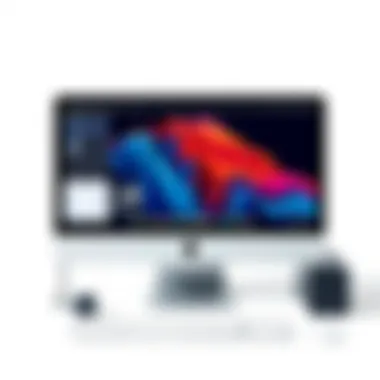Assessing iMac's Capabilities for Gaming


Intro
Gaming on a desktop has been synonymous with powerful performance and extensive customizability, but Apple’s iMac has sparked debate on its role as a gaming machine. Can these sleek and stylish devices hold their own against traditional contenders? Spoiler alert: it isn’t a straightforward yes or no.
In this exploration, we’re going to delve deep into the hardware and software aspects of the iMac when it comes to gaming. We’ll look at both its strengths and weaknesses, dissecting specifications, performance metrics, and the user experience on these machines.
The emphasis is not just on raw power, but also how well the iMac integrates into the gaming ecosystem. As gaming continues to evolve—with ever more demanding titles and immersive experiences—understanding where the iMac stands in this domain is crucial for tech enthusiasts and IT professionals alike who might be considering a full-fledged gaming setup on Apple's platform.
Foreword to iMac and Gaming
When it comes to gaming, the discussion often veers toward the complex worlds of custom-built PCs and gaming consoles. However, Apple's iMac tends to fly under the radar in these conversations. This article aims to shine a light on the iMac's viability as a gaming rig, exploring its architectural prowess and the gaming landscape's evolution on macOS.
The importance of this topic lies in understanding whether an iMac can hold its own against dedicated gaming systems. As gaming becomes an ever more expansive and demanding hobby, discerning IT professionals and tech enthusiasts need to take stock of what options are available. The iMac represents a blend of aesthetics, performance, and user-friendliness, making it a curious contender in the gaming arena.
Understanding the iMac Architecture
The architectural design of the iMac is quite unique compared to traditional gaming PCs. At its core, the iMac utilizes a sleek all-in-one setup, combining the computer's performance with a high-resolution display. The components are meticulously engineered to work together seamlessly, emphasizing efficiency over mere power.
Typically, an iMac features Apple's own M-series chips, known for their powerful processing capabilities and energy efficiency. The latest models also incorporate unified memory architecture, which facilitates quicker data access by allowing different components to share the same memory pool. This is a significant divergence from standard setups, where discrete components may hinder performance due to bottlenecks.
In terms of design, the iMac stands out. Its aluminum body not only gives it a premium feel but also aids in effective heat management—an important factor when gaming can push hardware to its limits. The integrated graphics solutions in many iMacs aim to balance performance while maintaining aesthetic appeal, allowing users to enjoy high-quality visuals with a monitor that enhances their workspace.
The Evolution of Gaming on macOS
Looking back, gaming on macOS has seen a notable transformation. Many years ago, the gaming library available to Mac users was limited. However, there's been a marked shift in recent years, with developers beginning to recognize the potential of macOS as a reliable gaming platform.
Initially, gaming on a Mac meant compromising on graphics quality or finding workarounds to run Windows games through emulators or virtual machines. While such methods still exist, the landscape is changing. More developers are releasing titles compatible with macOS, and even some AAA games have made their way onto the platform.
Platforms like Steam have made significant strides in offering macOS-friendly options, bridging the gap between gamers on different ecosystems. Today, many titles are not just playable but optimized for the Apple environment, showcasing improvements in graphics and performance.
Key Specifications for Gaming
When examining the iMac as a viable gaming PC, understanding its key specifications is vital. The performance of any gaming setup hinges heavily on several core components that determine how well it can handle modern gaming demands. In this section, we will explore the processor performance, graphics capabilities, as well as memory and storage considerations of the iMac, each playing a significant role in its gaming viability.
Processor Performance
Intel vs M-series Chips
The choice between Intel processors and Apple’s M-series chips is not merely a flag-waving exercise; rather, it delves deep into the heart of performance. Intel’s chips have long been the standard in gaming, providing dependable performance with established gaming frameworks. However, Apple’s M-series chips, specifically designed for their ecosystem, introduce a new paradigm in processing power.
One of the characteristic features of M-series chips is their ARM architecture, which has proved efficient at executing numerous tasks simultaneously while using less power. This efficiency aids in sustaining smooth gaming experiences, making them appealing options for potential iMac users who prioritize gaming.
While Intel still holds an edge in some high-end gaming scenarios, the efficiency of the M-series becomes apparent in titles optimized for macOS which often run smoother due to optimizations in integrated performance.
Multi-core Performance
Multi-core performance can make or break a gaming experience. As more games tap into the capability of handling multiple threads simultaneously, having a processor that can efficiently manage this task is crucial. The M1 and M2 chips, for example, feature several cores designed for both high performance and efficiency, allowing for seamless gaming even with demanding graphics.
Booming performance in CPU-intensive games like "Cyberpunk 2077" is often tied to how well the processor handles multiple cores working together. An iMac equipped with M-series chips might handle these tasks deftly while also maintaining energy efficiency, posing less concern about overheating or power consumption during gameplay.
Graphics Capabilities
Integrated vs Dedicated GPUs
Understanding the difference between integrated and dedicated GPUs is essential for graphics-heavy gaming. Integrated GPUs, built into processors like Apple's M-series, offer convenience and compact design. They utilize system memory for processing graphics which can limit gaming performance in resource-intensive scenarios.


On the flip side, dedicated GPUs provide a more robust solution for serious gamers. They possess their own dedicated VRAM, allowing for higher frames per second (FPS) and improved visual fidelity in demanding game titles. The latest iMac models include options for dedicated graphics cards such as the AMD Radeon Pro, widely recognized for elevating gaming graphics performance significantly above integrated alternatives.
Current GPU Options in iMac
Currently, iMac offers a variety of GPU options, allowing users to select according to their gaming needs. Many models feature high-performing dedicated GPUs, but the increasing popularity of integrated solutions calls for attention. Choices such as the AMD Radeon Pro GPUs enhance the gaming experience with cutting-edge rendering features, making modern titles visually stunning.
However, potential buyers should bear in mind that while dedicated GPUs offer exceptional performance, they also come with additional costs, -which can impact the overall investment in an iMac for gaming. Selecting the right balance between performance and cost becomes a relevant consideration for gamers assessing their needs.
Memory and Storage Considerations
RAM Requirements for Gaming
The importance of RAM in a gaming context cannot be overstated. Games demand adequate RAM for smooth operation, thus ensuring that multiple tasks can happen without noticeable lag. Generally, 16GB is seen as a comfortable entry point for modern gaming on any platform, including the iMac. However, those looking for a future-proof experience might want to consider configurations that offer 32GB, especially for RAM-intensive titles.
Moreover, the unified memory architecture in Apple's M-series chips can increase performance efficiency by allowing data to be shared between CPU and GPU, resulting in faster load times and smoother gameplay.
SSD vs HDD for Load Times
When it comes to storage, there’s a dividing line between SSDs and HDDs. The performance difference is stark; SSDs, with their high-speed data access capabilities, dramatically reduce load times when compared to traditional HDDs. This is particularly crucial in gaming as waiting for games to boot can dampen enthusiasm.
As a part of Apple’s commitment to performance, all recent iMacs come equipped with SSDs, giving gamers the edge they need in load times. The responsiveness of an SSD can mean the difference between defeating a boss or being sent back to the starting line. Plus, with more titles being optimized for SSD performance, this makes investing in an iMac more appealing even for dedicated gaming experiences.
In summary, the key specifications discussed serve as a foundation for understanding the iMac as a gaming machine. By evaluating processor perfomance, graphics capabilities, memory, and storage, potential buyers can make informed decisions about the utility of an iMac in the gaming landscape.
Gaming Compatibility with macOS
Gaming on macOS has long been met with skepticism by serious gamers. Unlike Windows, which enjoys a vast library of games, macOS has often been overlooked, making its compatibility a vital topic in this exploration of iMac as a gaming computer. This section delves into the significance of gaming compatibility and what it really means for potential iMac owners who wish to game on their system.
While it's true that many major titles have been either unavailable or poorly optimized for macOS, the landscape has shifted, albeit slowly. Much like navigating through a maze, finding the right games for macOS requires persistence and a bit of forethought.
Popular Games Available on macOS
Despite the challenges, a noteworthy selection of games can be found on the macOS platform. Titles such as "Civilization VI", "World of Warcraft", and "Stardew Valley" have made their mark among macOS gamers. Their availability shows that while the selection isn’t as extensive as on Windows, it isn’t devoid of quality.
- Civilization VI: A turn-based strategy game that allows players to build an empire. Its rich graphics and intricate gameplay translate well on the iMac's display.
- World of Warcraft: This classic MMORPG combines extensive lore with social play. Blizzard's optimization for macOS keeps many players engaged.
- Stardew Valley: A farming simulation game that has captivated audiences of all ages, proving that indie games can thrive on this platform.
This just scratches the surface, but it also highlights the need for users to explore what’s available. Resources like MacGameStore provide updated lists of compatible games, often including indie gems that you may not find elsewhere.
Using Emulators and Wine for Windows Games
For gamers looking to broaden their experience, emulators and programs like Wine are handy tools. Emulators allow you to run software from other platforms. Meanwhile, Wine, which acts as a compatibility layer, enables Windows applications to run on macOS.
Some notable examples include:
- Wine: With it, you can run many Windows-exclusive games, opening up many gaming doors. Just bear in mind that performance can be less than stellar at times.
- Parallels Desktop: This software allows users to run Windows alongside macOS, providing a seamless transition between both operating systems.
Using these tools can be a bit hit or miss, and patience is often required during setup. However, they do serve as viable alternatives for those hell-bent on playing their favorite Windows titles.
Performance of Cross-Platform Games
Cross-platform games often provide the best of both worlds, with improved performance and wider compatibility. Titles such as "Fortnite", "Minecraft", and "Rocket League" have managed to bridge the gap, allowing macOS users to connect with players on other platforms.
The benefits of these games include:
- Consistent Updates: Developers who focus on cross-platform functionality tend to maximize compatibility and performance across systems.
- Robust Multiplayer Options: Many of these games support seamless multiplayer, meaning a larger pool of players to engage with.
Instruments such as Apple's Metal API enhance performance further, making graphics rendering smoother, allowing gamers to enjoy a heightened experience. However, it’s wise to keep expectations realistic; some heavy hitters may still lag behind in optimization compared to their Windows counterparts.


In summary, while macOS gaming may not be as straightforward as on other platforms, advancements in technology, game availability, and third-party solutions have made significant strides. For those willing to adapt and explore, there is an engaging gaming experience waiting in the wings.
Pros and Cons of Using iMac for Gaming
Evaluating whether an iMac is a suitable gaming rig requires diving into its strengths and weaknesses. This isn’t just about specs; it’s about how these characteristics play out in real-world gaming scenarios. For many, the iMac is synonymous with productivity and design. However, from a gaming perspective, weighing the pros and cons can provide invaluable insights. The aim here is to set the record straight for gamers who might be considering the iMac as their gaming machine.
Advantages of the iMac
Design and Aesthetics
The first thing anyone notices about the iMac is its striking design. With its sleek aluminum chassis and minimalistic profile, it catches the eye right away. This design not only makes it a centerpiece in any room but also impacts its functionality. Many appreciate how it appears seamlessly integrated with modern decor, making it a popular choice for those who value style alongside substance.
However, the aesthetics also mean a more compact system that integrates the display and hardware into a single unit. This setup can lead to a cleaner desktop, which is a big plus for many people. Still, some might argue that the beautiful design comes at a price— options for extensive upgrades can be minimal.
User-Friendly Experience
A key characteristic of the iMac's user-friendly experience is the macOS operating system. It is often described as intuitive and streamlined. The uniformity of Apple’s ecosystem means that apps run smoothly and are generally optimized for performance. For gamers, this can translate into a more pleasant experience, especially when configuring settings or navigating through game libraries.
One downside could be the reliance on closed ecosystems, which can sometimes hamper access to popular gaming titles or updates that you’d find more readily available on Windows. However, for users already familiar with macOS, the familiarity can make it seem like a breeze to manage gaming applications.
Limitations of the iMac
Upgrade Constraints
One of the most frequently cited downsides of the iMac is its upgrade constraints. Unlike traditional gaming PCs, which often allow for easy upgrades of components like the graphics card or RAM, the iMac’s design is inherently limiting. Once you buy your iMac, that’s generally what you’re stuck with over the long term.
This can become an issue, particularly as games become more demanding. Players who enjoy the latest titles at high settings may find their hardware lagging behind sooner than expected. While many iMacs come equipped well enough for casual to moderate gaming, growth within gaming technology may leave older models behind without easy paths for improvement.
Heat Management Issues
Heat management is another significant concern. The all-in-one design strategy might lead to thermal constraints. Users often report that prolonged gaming sessions can result in the iMac running noticeably hotter than they expected. The compact design can restrict airflow which may lead to performance throttling during intense gaming.
A potential workaround would be using external cooling solutions, but this would seemingly contradict the initial allure of a clean, space-saving setup. Ongoing heat issues could be worrying for gamers who plan to dive deep into high-resource games for extended sessions.
"Choosing the right gaming setup can be as critical as the games you wish to play. Knowing both the plusses and minuses can help you navigate through your options better, particularly with something as uniquely designed as the iMac."
Alternative Gaming Setups
In a world increasingly defined by diversified gaming experiences, exploring alternative setups beyond the traditional iMac proves invaluable. These alternatives open up a new realm of possibilities for gamers who wish to optimize their performance, tailor their configurations, and expand their gaming horizons. Let’s dive into the myriad of setups available, each offering unique advantages and presenting distinct considerations that cater to various preferences and needs.
Building a Custom Gaming PC
For a true gaming enthusiast, nothing beats the customization of a bespoke gaming rig. Building a custom gaming PC means putting together components that perfectly match your gaming style. From the processor to the graphics card, every piece can be chosen according to your needs. You might opt for higher clock speeds, larger caches, or even specialty hardware designed for particular gaming genres.
Benefits of a custom-built PC include:
- Flexibility: Pick parts that suit your preferences, whether that’s for graphics fidelity, speed, or budget.
- Performance: Higher-performance options usually translate to better frame rates and visual quality.
- Upgradability: It’s relatively easy to upgrade individual components as newer technology becomes available.
Considering the specifics, a reputable online community like reddit.com/r/buildapc could offer invaluable advice and insights. You'll find people sharing their expertise, pointers for budget builds, or even high-end setups.
Console vs. PC Gaming
The classic debate of console versus PC gaming often comes down to user preference. Consoles like PlayStation and Xbox offer a plug-and-play convenience that many users appreciate. On the flip side, PC gaming can be a more involved process but provides benefits that can captivate a more devoted audience.
Pros of consoles include:


- Ease of Use: No need to worry about hardware compatibility; just insert the disc or download your game and start playing.
- Cost-Effective: Initial investment usually lower than a high-performance gaming PC.
PC gaming, however, offers:
- Power and Flexibility: Capability to run demanding games with high settings and resolutions.
- Strong Communities: Access to online platforms and mods that enhance the gaming experience.
In the end, it comes down to what you want from your gaming experience. Whether you lean toward the simplicity of a console or the power of a well-crafted PC, each has its value based on personal demands.
Hybrid Solutions: Cloud Gaming
As technology evolves, cloud gaming has emerged as an interesting alternative to traditional setups. This approach allows gamers to play high-performance titles from virtually any device with an internet connection, eliminating the need for robust local hardware. Services like NVIDIA GeForce NOW or Google Stadia stream games directly to your device, meaning all processing happens in the cloud.
Potential advantages include:
- Accessibility: Guides can play demanding games on lower-end devices without compromising performance.
- Cost Savings: Reduces the need for expensive hardware upgrades and maintenance.
However, there are considerations to weigh against the apparent ease of cloud gaming. For one, the dependency on a stable internet connection can lead to lag or connectivity issues, which can ruin a gaming session. Additionally, users are often bound by subscription fees and library limitations, depending on the service they choose.
With cloud gaming becoming a viable option, it’s become essential to stay aware of technological trends, as they could reshape the way we engage with games for years to come. Explore resources like britannica.com for deeper insights into emerging gaming technologies.
Embracing and understanding alternative gaming setups not only enriches the gaming experience but also empowers gamers to curate an environment tailored to their desk and play style.
The Future of Gaming on iMac
As we steer into the future, the landscape for gaming on iMac is becoming increasingly intricate. The relevance of this topic cannot be overstated, especially for IT professionals and tech enthusiasts who are keen on understanding how Apple's machines might evolve to meet the demands of gamers. With emerging technologies and robust developments from Apple on the horizon, the viability of the iMac as a gaming platform may take on new dimensions.
Emerging Technologies and Gaming
The rapid pace of technological advancement plays a pivotal role in shaping the gaming experiences on various platforms, including the iMac. Currently, several trends are paving the way for better performance and richer gameplay.
- Ray Tracing and AI Enhancements: As the gaming industry increasingly embraces more realistic graphics, techniques like ray tracing have begun to find their way into mainstream use. These technologies demand significant processing power. How well future iMacs will support these capabilities depends on their upgrading of graphics technology.
- Cloud Gaming Services: The rise of cloud gaming is another game changer. Services like Google Stadia and NVIDIA GeForce Now have introduced gamers to streaming capabilities that don't require high-end hardware. Future iterations of iMac may become optimized to work seamlessly with these platforms, packaging a premium gaming experience without needing cutting-edge specs.
- VR and AR Technology: Virtual Reality (VR) and Augmented Reality (AR) represent frontiers in gaming yet to be fully explored. Continuous improvements in hardware could allow iMacs to support VR headsets and AR applications, providing a more immersive experience.
Keeping an eye on how these technologies mesh with Apple's computing environment will be essential for anyone considering the iMac as their gaming setup.
Expected Developments from Apple
Apple's approach to gaming has been somewhat conservative compared to its competitors. Nevertheless, it's prudent to acknowledge that the company increasingly recognizes the value of gaming in its ecosystem. There are a few anticipated developments that could reshape the gaming experience on iMac:
- Hardware Upgrades: Rumors suggest significant enhancements in forthcoming iMac models, particularly in their graphics capabilities and processing power. The integration of better ARM chips could dramatically benefit gaming performance.
- Software Optimization: The evolution of macOS is also crucial. Future updates might bring tighter integration with gaming ecosystems. Compatibility and performance optimizations for existing gaming platforms could alleviate some of the current limitations.
- Partnerships with Game Developers: There’s potential for Apple to create partnerships with major game developers. This could lead to beautifully crafted, exclusive games tailored for macOS, improving the appeal of the iMac to gamers.
"As we look ahead, predictably aligning iMac's growth trajectory with emerging gaming needs will be essential for Apple's long-term strategy."
The future of gaming on the iMac holds promise, but it’s important to remain grounded in the ongoing developments and how they can influence user experience. Keeping a keen eye on these trends can illuminate the path forward for potential buyers.
Closure
The topic of using iMac for gaming carries substantial weight in today's tech-savvy world, especially among IT professionals and tech enthusiasts. As gaming becomes increasingly integrated with everyday tech use, understanding how and why the iMac fits within that paradigm is crucial.
Final Thoughts on iMac Gaming
Many users, especially those who play casually or enjoy games that are compatible with macOS, find the iMac a suitable option. Additionally, with the emerging technologies discussed in previous sections, a clearer picture arises of how gaming on this platform might evolve in the coming years. Yet, as we’ve established, potential buyers should weigh these final considerations carefully.
Recommendations for Potential Buyers
For potential buyers of an iMac with gaming in mind, it’s paramount to look at a few key factors:
- Assess Your Gaming Style: If you identify as a casual gamer who enjoys titles like Civilization VI or Stardew Valley, then an iMac will likely meet your needs. However, if you lean towards fast-paced, graphically intensive games, you might want to consider alternatives.
- Consider Future Needs: Think about whether your gaming usage might escalate. Will you enjoy only casual games now but potentially dive into more intensive titles later?
- Check for Specs Against Games: Always do a bit of research on the types of games you want to play. Match that against the specs of the iMac you’re considering. Look specifically at RAM and GPU capabilities.
- Optimize Your System: Take time to configure your system settings to maximize performance, perhaps by limiting background applications when gaming or adjusting graphical settings in-game for a smoother experience.
Before making a decision, evaluating personal gaming preferences and balancing them against what the iMac offers can lead to a more satisfying purchase. For further insights into alternative gaming platforms or specific configurations, consider visiting resource sites like Wikipedia or tech forums on platforms like Reddit.
"An informed choice is better than a beautiful box that underdelivers on performance."
By keeping these elements in mind, potential buyers will be better equipped to determine if the iMac stands as a viable gaming solution for their unique needs.



